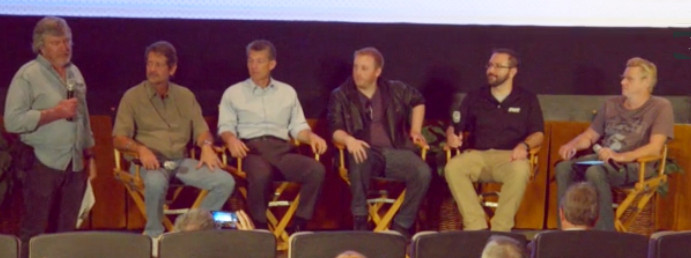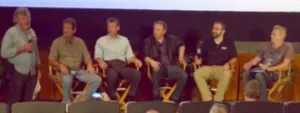The Digital Cinema Society (DCS) is an organisation we keep a watching brief on. The group recently held an event in Hollywood on “4 Ways to a 4K Finish”, which included talks on storage and editing in 4K. There are some interesting videos online at http://tinyurl.com/qj8blnp
 DCS Panel: Source:DCS
DCS Panel: Source:DCS
Michael Krulik of Avid said that while productions may not be edited or delivered 4K, but teams are capturing in 4K partly because (especially in reality shows) a single 4K shot may be cut three different ways to be used in the production. (Another speaker mentioned that he is making a “reality” TV show that uses multiple 4K GoPros for the same reason). When the industry moved from SD to HD, DNX-HD was introduced and now there is a DNX-HR codec to cope with higher than 1080P.
Tom Vice of Foto Kem looked at the company’s 4K workflow. The firm has its own ingest system called NextLab that can take content up to 8K. He also talked about how the company takes 35mm film content for feature films and scans at 4K so that film content can be integrated fully into the digital workflow. It can also support 65.5mm 5 perf film and has done so for a film maker and scanned the film at 8K, but used downscaled at 4K for DCI. That’s how Lawrence of Arabia and the Sound of Music were made into very high quality digital formats. The company is actively working with HDR and Vice said that a recent project scanned film at 6K and scale to 4K. There was “no difference”, Vice said, between the 2K and 4K content, but when the client was shown HDR, it was better than the 4K, so the client is looking at HDR to exploit library content, but not bothering with 4K.
Kevin Monahan of Adobe said that since CS5, Adobe has been supporting 4K for some time, which started with support of Red cameras. “Gone Girl” was recently created as a feature film in Premiere Pro. Particular features of Premiere Pro include LUT support and can work with RAW files. The new version supports HDR and it also outputs H.265 to allow export at up to 8K. He also said that you can get “decent” performance on 4K content, by downscaling, even on a moderate PC.
Some interesting comments came from Brian Mcmahon of Modern VideoFilm who said, several times, in his comments during the panel session, that monitoring of 4K is a significant problem, still. “All the monitors look different” and off axis performance is very concerning. It looks good on cinema projectors, “beautiful” he said (and with HDR to come soon). Mcmahon said that 60%-75% is still in 2K, but archiving is in 4K as is restoration. Mcmahon also said that you need “a lot of computing power” to work live on 4K, still. The software may be here, but “the hardware is not free”.
He also said that there are “a lot of gotchas” in HDR because it is so new.

